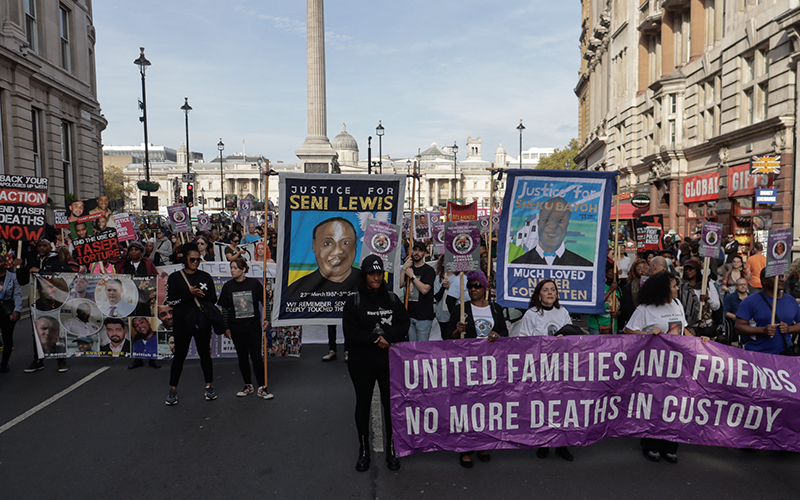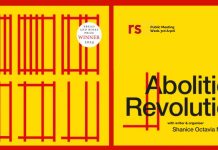Charlotte Powell reviews Abolition Revolution (2022), a new book by Avaia Sarah Day and Shanice McBean which Pluto Press describes as a ‘historical, theoretical and practical guide to revolutionary abolitionist politics in Britain’.

Chris Kaba, Jean Charles de Menezes, Cynthia Jarret, Sheku Bayoh, Ian Tomlinson, Cherry Groce – just a few of the people killed by police in Britain in recent decades. Add to that the 1,851 deaths since 1990 of people in police custody or following contact with police. Add to that events like Hillsborough in 1989, where 97 Liverpool fans died due to police negligence. Add to that all the kids roughed up by cops each day in racist stop and searches and other routine activity – brutal, but not brutal enough to be news. Add to that all the illegal evictions where the police side with the landlord instinctively and make people homeless. Add to that all the times when the police have protected fascists on the streets, and all the times the police have attacked strikers on picket lines.
It’s easy to show that the British police are pigs. It’s also easy to see that we are heading into troubled times, with a growing need to protest over climate, migration and much more, while protest is increasingly criminalised. This combination can lead towards a general anti-police sentiment. If that was what abolition was about, it would be more easily co-opted by the mainstream. But abolition is about more than that and very specific – it’s about the need to get rid of police and prisons entirely, not just the aspects of them that are particularly bad. For that reason, a lot of revolutionaries who believe in the working-class overthrow of capitalism aren’t sold on abolition as a specific idea.
Abolition Revolution by Shanice McBean and Aviah Sarah Day is a first step to bridging the gap between revolutionary politics and police and prison abolition. There are activists involved in abolitionist organising who either don’t talk about or don’t support revolution as a horizon that is essential for abolition, and there are lots of revolutionaries on the socialist/communist left who either don’t consider or don’t support abolition as an essential component of the revolutionary process. Abolition Revolution addresses both of these groups. It clearly demonstrates the links between capitalism, imperialism, race and racialisation and state power, from policing to lawmaking and propaganda. It demonstrates why abolition and social revolution need each other. Going beyond just saying why we should all be abolitionist revolutionaries, it also tells us how we can build revolutionary organising that is abolitionist and how we can build abolitionist organising that is revolutionary.
The book is made up of 16 theses, intended as individually digestible arguments. The introduction sets the scene, describing the context in which the book came about – summer 2020, when Black Lives Matter protests spread to Britain from the USA, and the subsequent Kill the Bill movement in 2021 against the Police, Crime, Sentencing and Courts Bill. In this context, activist group Sisters Uncut developed from an organisation determined ‘to protect the national network of domestic violence services from closure’ to an abolitionist organisation leading the charge against new repressive legislation in the wake of the murder of Sarah Everard.
After that, the rest of the theses are divided up into four sections:
- The tools of police power
- Roots in empire: the history of criminalisation and resistance
- Systems of criminalisation today
- Abolitionist Futures
A fifth section provides a transcription of conversations at an abolitionist symposium.
Because each chapter is a self-contained thesis as well as part of a whole, the book is hugely rich and wide-ranging. This review could easily go on for ages responding to all of the questions, challenges, and insights raised by each thesis. Instead, I’ll talk about why the book is useful, the role I hope it can play in bridging abolitionist and socialist organising, and what further work the book makes possible.
Community, organisation, and power
The different theses of the book build up its core ideas like the best patchwork – ordered, patterned, and rhythmic. Where one thesis will focus on borders, another will focus on abolitionist feminism, and another on islamophobia and Prevent legislation. Some focus on charting the development of police and prisons as they are today, providing a great overview of the centrality of colonialism to the development of policing which was then turned on the British working class. Others provide deep political analysis, like Thesis 3: ‘Race is at the heart of policing; without race policing can’t function. Dismantling the police means dismantling race.’
I found it interesting comparing Abolition Revolution with Abolition. Feminism. Now. by Angela Davis, Gina Dent, Erica Meiners, and Beth Richie, which was published a bit less than a year earlier. Zad El Bacha in a review of the latter book wrote that ‘the authors view building networks of care as a way of building power’, but that the relationship between building care (i.e. small networks and groups, mutual aid work, community building, transformative justice work) and power (i.e. building fighting organisations that aim to grow big enough to win specific goals) presented in the book wasn’t fully clarified.
Day and McBean have been connecting these dots for their whole activist lives, and it shows. Abolition Revolution has a clear perspective on how these forms relate to each other. Through examples ranging from the Grunwick strike to resisting immigration raids in Hackney, they present a model of communities and organisations working together, where building organisational infrastructure is an essential complement to more organic explosions of resistance. ‘Patient community organising can prepare us for these spontaneous rehearsals in revolution, where mass withdrawal of consent becomes possible.’
This leaves open a lot of questions about how less radical organisations – like big trade unions – fit into the picture. The issues and betrayals possible when fighting alongside these organisations are touched on briefly in the book’s discussion of the Grunwick Film Processing Laboratories strike. But even with the questions of how to navigate those broader coalitions left unanswered, I think this is a big step forward in articulating a strategy for abolitionist politics. We can build unity between organisations of different kinds within and across communities and struggles as a way of building power toward revolution.
Abolitionism and socialism
Abolitionist strategy as described in this book has a few key planks:
- Building alternative community responses to harm, aiming to build transformative justice practices that can be turned to instead of police
- Working to undo public consent to policing, so the publicly acceptable violence of arrests, raids, evictions etc become less and less widely accepted
- Building capacity for interventions that disrupt policing, such as by filming police during racist stop and searches, physically de-arresting activists at protests by grabbing them back off the police, and stopping immigration raids by mass protest (Abolition Revolution highlights the spread of anti-raids and Copwatch networks as key to the future of the movement)
- Resisting laws like the Prevent duty that compels workers to take on a policing role in schools, hospitals, universities etc.
Revolutionary strategy revolves around the working class seizing and smashing state power. In an orthodox socialist model of change, workers organise and build power in the workplace, go on strikes, then on mass strikes, then on general strikes, and a mass workers’ party articulates the revolutionary aims of this activity, developing the political demands of the movement as it builds power.
Abolition Revolution gives anyone wanting to make the argument in socialist spaces the material to present abolitionism as a crucial component of socialist politics. During Marx and Engels’ lifetime, the abolition of standing armies was a key socialist demand. From then on, anti-militarism was a key organising aspect of socialist politics. In the twentieth century this anti-militarism increasingly refocused on police and particularly racial oppression by police.
These two threads – organising in workplaces and in communities – have often been insecurely linked together. But if we get close to seizing power, we want the liquidation of the repressive arm of the state and in the meantime we attempt to weaken it and, historically, to sow dissension within its ranks. Abolitionism is a framework for direct confrontation with one of the key weapons being turned on us by the ruling class. This allows the working class movement to grow in power and gives it more room to manoeuvre.
From here to the horizon
As I’ve said, Abolition Revolution provides a brilliant guide to the history of imperialism, racism, class struggle, and the development of different forms of state repression. The authors build up a comprehensive picture of the ways this repression works today, from its most brutal to its most subtle forms. They point to the key strands of current organising in Britain that should be woven together as a way forward. What the book doesn’t do is chart a road-map between the short-term future organising priorities it describes and the long-term horizon of abolitionist revolution. That medium-term is the time where the power of the working class movement will grow and there will be more direct confrontation with state power and the capitalist ruling class. Abolition Revolution argues that this will have to escalate to a revolutionary overthrow of that class and smashing of that state power in order for us to see the end of prisons and police. But that medium-term process of going from contesting state power to smashing it is not mapped out for us.
But a strategy for this medium-term between immediate abolitionist work and the revolution is exactly what is needed. And we can build it based on the amazing bedrock that Abolition Revolution has given us. As Day and McBean write in the final thesis, ‘Abolition must work towards the wider goal of seizing the land, natural resources and wealth stolen from us by capitalists: abolition must work in service of proletarian revolution.’ Get hold of a copy of this book, read it with some comrades, and start talking about how we can get there from here.

















